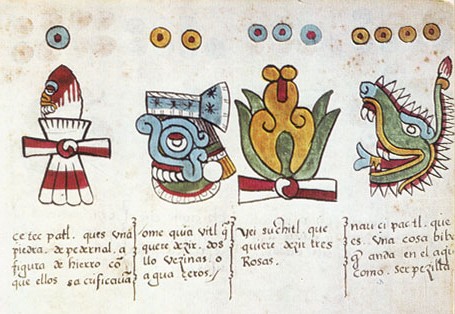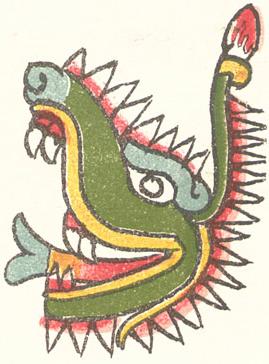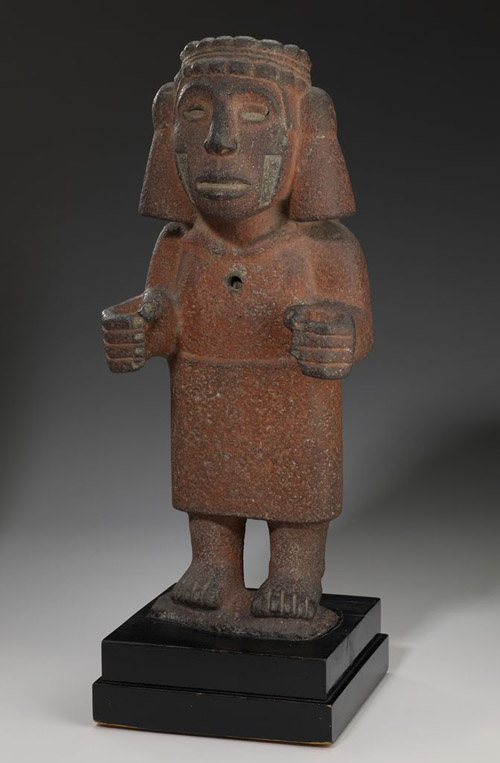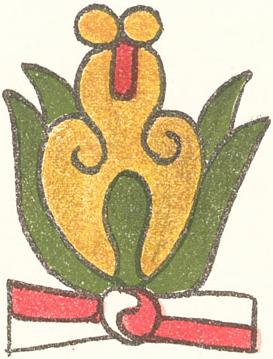|
Tōnalpōhualli
The (), meaning "count of days" in Nahuatl, is a Mexica version of the 260-day calendar in use in pre-Columbian Mesoamerica. This calendar is solar and consists of 20 13-day () periods. Each is ruled by a different deity. Graphic representations for the twenty day names have existed among certain ethnic, linguistic, or archaeologically identified peoples. Description The basis of the is unknown. Several theories have been advanced for this calendrical period: that it represents a Venusian cycle, that it represents the human gestation period, or that it represents the number of days between the zenithal passage of the sun in the tropical lowlands. On the other hand, some scholars including J. E. S. Thompson suggest that the was not based on natural phenomena at all, but rather on the integers 13 and 20, both considered important numbers in Mesoamerica. The other major Mexica calendar, the , is a 365-day year, based on 18 months of 20 days and five nameless days. A was ... [...More Info...] [...Related Items...] OR: [Wikipedia] [Google] [Baidu] |
Codex Magliabechiano 11R
The codex (plural codices ) was the historical ancestor of the modern book. Instead of being composed of sheets of paper, it used sheets of vellum, papyrus, or other materials. The term ''codex'' is often used for ancient manuscript books, with handwritten contents. A codex, much like the modern book, is bound by stacking the pages and securing one set of edges by a variety of methods over the centuries, yet in a form analogous to modern bookbinding. Modern books are divided into paperback or softback and those bound with stiff boards, called hardbacks. Elaborate historical bindings are called treasure bindings. At least in the Western world, the main alternative to the paged codex format for a long document was the continuous scroll, which was the dominant form of document in the ancient world. Some codices are continuously folded like a concertina, in particular the Maya codices and Aztec codices, which are actually long sheets of paper or animal skin folded into ... [...More Info...] [...Related Items...] OR: [Wikipedia] [Google] [Baidu] |
Cipactli
Cipactli ( nci, Cipactli "crocodile" or "caiman") was the first day of the Aztec divinatory count of 13 X 20 days (the '' tonalpohualli'') and ''Cipactonal'' "Sign of Cipactli" was considered to have been the first diviner. In Aztec cosmology, the crocodile symbolized the earth floating in the primeval waters. According to one Aztec tradition, ''Teocipactli'' "Divine Crocodile" was the name of a survivor of the flood who rescued himself in a canoe and again repopulated the earth. In the Mixtec Vienna Codex ( Codex Vindobonensis Mexicanus I), Crocodile is a day associated with dynastic beginnings. In Aztec mythology, Cipactli was a primeval sea monster, part crocodilian, part fish, and part toad or frog, with indefinite gender. Always hungry, every joint on its body was adorned with an extra mouth. The deity Tezcatlipoca sacrificed a foot when he used it as bait to draw the monster nearer. He and Quetzalcoatl created the earth from its body. Karl A. Taube has noted that among the ... [...More Info...] [...Related Items...] OR: [Wikipedia] [Google] [Baidu] |
Chalchiuhtlicue
Chalchiuhtlicue (from ''chālchihuitl'' "jade" and ''cuēitl'' "skirt") (also spelled Chalciuhtlicue, Chalchiuhcueye, or Chalcihuitlicue) ("She of the Jade Skirt") is an Aztec deity of water, rivers, seas, streams, storms, and baptism. Chalchiuhtlicue is associated with fertility, and she is the patroness of childbirth. Chalchiuhtlicue was highly revered in Aztec culture at the time of the Spanish conquest, and she was an important deity figure in the Postclassic Aztec realm of central Mexico. Chalchiuhtlicue belongs to a larger group of Aztec rain gods, and she is closely related to another Aztec water god called Chalchiuhtlatonal. Religious significance Chalchiuitlicue directly translates to "Jade her skirt"; however, her name is most commonly interpreted as "she of the jade skirt." She was also known as Chalchiuhtlatonac (chalchihu tltla-tona-c) "She who shines like jade" and Matlalcueye "Possessor of the Blue Skirt" by the Tlaxcalans, an indigenous group who inhabited ... [...More Info...] [...Related Items...] OR: [Wikipedia] [Google] [Baidu] |
Coatl
__NOTOC__ Coatl (also spelled cohuatl, couatl, or cuatl) is a Nahuatl word meaning "serpent" or "twin" (). It is the name of one of the day-signs in the Aztec Calendar. It can also refer to: * Coatl, a character from the 1945 novel, ''Captain from Castile'' (novel) ** Also appears in the 1947 film adaptation, ''Captain from Castile'' * Couatl (Dungeons & Dragons), a type of creature in the ''Dungeons & Dragons'' fantasy roleplaying game * Coatl (wood), a type of wood also used in traditional medicine * Lamborghini Coatl, a Lamborghini concept vehicle See also * Coatli (other), a Nahuatl word referring to several medicinal plants * Quetzalcoatl Quetzalcoatl (, ; Spanish: ''Quetzalcóatl'' ; nci-IPA, Quetzalcōātl, ket͡saɬˈkoːaːt͡ɬ (Modern Nahuatl pronunciation), in honorific form: ''Quetzalcōātzin'') is a deity in Aztec culture and literature whose name comes from the Na ..., the Aztec deity whose name means "feathered serpent" {{disambiguation, pla ... [...More Info...] [...Related Items...] OR: [Wikipedia] [Google] [Baidu] |
Huēhuecoyōtl
In Aztec mythology, Huehuecóyotl (from ''huēhueh'' "very old" (literally, "old old") and ''coyōtl'' "coyote" in Nahuatl) is the auspicious Pre-Columbian god of music, dance, mischief, and song. He is the patron of uninhibited sexuality and rules over the day sign in the Aztec calendar named cuetzpallin (lizard) and the fourth trecena Xochitl ("flower" in Nahuatl). History Stories derived from the Codex Telleriano-Remensis characterized Huehuecóyotl as a benign prankster, whose tricks were often played on other gods or even humans, but tended to backfire and cause more trouble for himself than for the intended victims. A great party-giver, he also was alleged to create wars among humans to relieve his boredom. He was a part of the Tezcatlipoca (Smoky Mirror) family of the Mexica gods and inherited their shapeshifting powers. Those who had indications of evil fates from other gods would sometimes appeal to Huehuecóyotl to mitigate or reverse their fates. Huehuecóyot ... [...More Info...] [...Related Items...] OR: [Wikipedia] [Google] [Baidu] |
Tepēyōllōtl
In Aztec mythology, Tepēyōllōtl (; "heart of the mountains"; also Tepeyollotli) was the god of darkened caves, earthquakes, echoes and jaguars. He is the god of the Eighth Hour of the Night, and is depicted as a jaguar leaping towards the sun. In the calendar, Tepeyollotl rules over both the third day, Calli (house), and the third trecena, 1-Mazatl (deer). The word is derived as a compound of the Nahuatl words ' ("mountain"), and ' ("heart" or "interior"). Tepeyollotl is usually depicted as cross-eyed holding the typical white staff with green feathers. Sometimes Tezcatlipoca Tezcatlipoca (; nci, Tēzcatl ihpōca ) was a central deity in Aztec religion, and his main festival was the Toxcatl ceremony celebrated in the month of May. One of the four sons of Ometecuhtli and Omecihuatl, the God of providence, he is a ... wore Tepeyollotl for an animal skin or disguise to trick other gods into not knowing who he was. References Aztec gods Nature gods Mythological f ... [...More Info...] [...Related Items...] OR: [Wikipedia] [Google] [Baidu] |
Quetzalcoatl
Quetzalcoatl (, ; Spanish: ''Quetzalcóatl'' ; nci-IPA, Quetzalcōātl, ket͡saɬˈkoːaːt͡ɬ (Modern Nahuatl pronunciation), in honorific form: ''Quetzalcōātzin'') is a deity in Aztec culture and literature whose name comes from the Nahuatl language and means "Precious serpent" or " Quetzal-feathered Serpent". In the 17th century, Ixtlilxóchitl, a descendant of Aztec royalty and historian of the Nahua people, wrote, "Quetzalcoatl, in its literal sense, means 'serpent of precious feathers', but in the allegorical sense, 'wisest of men'." Among the Aztecs, whose beliefs are the best-documented in the historical sources, Quetzalcoatl was related to gods of the wind, of the planet Venus, of the dawn, of merchants and of arts, crafts and knowledge. He was also the patron god of the Aztec priesthood, of learning and knowledge. Quetzalcoatl was one of several important gods in the Aztec pantheon, along with the gods Tlaloc, Tezcatlipoca and Huitzilopochtli. Two other gods ... [...More Info...] [...Related Items...] OR: [Wikipedia] [Google] [Baidu] |





